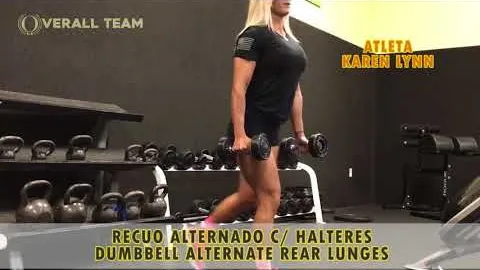
Dumbbell alternate rear lunges are a dynamic and efficient exercise that target multiple muscle groups, including the quadriceps, glutes, hamstrings, and calves. This exercise is beneficial for individuals of all fitness levels, from beginners to advanced athletes. In this guide, we will provide step-by-step instructions on how to perform the dumbbell alternate rear lunge properly, along with the benefits and variations of this exercise.
To begin the dumbbell alternate rear lunge exercise, follow these steps:
Step One: Stand tall with your feet shoulder-width apart and hold a dumbbell in each hand, with your palms facing your body. Maintain a neutral grip on the dumbbells.
Step Two: Take a step backward with your left leg, ensuring that your right leg remains rooted in place. Lower your body by bending your right knee, allowing it to form a 90-degree angle. Simultaneously, lower your left knee towards the ground, almost touching it lightly.
Step Three: Push through your right heel to return to the starting position, while lifting your left leg back to the starting position beside your right leg.
Step Four: Repeat the same movement on the opposite side, taking a step backward with your right leg and lunging down. Remember to keep your core engaged and maintain a straight back throughout the exercise.
Step Five: Continue alternating sides for the desired number of repetitions.
To maximize the effectiveness of the dumbbell alternate rear lunge exercise and prevent injury, it is essential to maintain proper form and technique. Consider these tips:
Incorporating dumbbell alternate rear lunges into your exercise routine can provide a plethora of benefits for your overall fitness and strength. Some notable advantages include:
Strengthening Lower Body Muscles: Dumbbell alternate rear lunges target the quadriceps, glutes, hamstrings, and calves, making it an incredibly effective lower body exercise. This exercise helps to build muscle strength and power while also improving muscular endurance.
Improving Balance and Stability: Due to its unilateral nature, the dumbbell alternate rear lunge requires a greater amount of balance and stability. This exercise challenges your core muscles and enhances coordination between both sides of your body.
Enhancing Functional Movement Patterns: The mechanics involved in the dumbbell alternate rear lunge closely mimic real-life movements, such as walking or climbing stairs. By improving your ability to perform these movements efficiently, you can enhance your overall functional fitness.
Increasing Caloric Expenditure: Lunges, particularly when performed with added resistance, like dumbbells, can significantly increase the calorie burn during your workout. This makes the dumbbell alternate rear lunge an excellent exercise for those looking to support weight loss or maintenance goals.
Versatility and Adaptability: The dumbbell alternate rear lunge can be easily modified to suit individual fitness levels. By adjusting the weight of the dumbbells used, the number of repetitions, or the depth of the lunge, you can tailor the exercise to meet your specific needs and goals.
Once you have mastered the basic form of the dumbbell alternate rear lunge, you can switch things up by incorporating different variations. Some variations you can try include:
Dumbbell Front Rack Lunge: Instead of holding the dumbbells at your sides, hold them at shoulder height in a front rack position. This variation further challenges your core stability and upper body strength.
Dumbbell Overhead Lunge: Hold the dumbbells directly overhead, with your arms fully extended. This variation increases the demands on your shoulder stability, core strength, and overall balance.
Curtsy Lunge: Start in a standing position with your feet hip-width apart. Instead of stepping directly backward, cross your left leg behind your right leg and perform a lunge. Alternate sides for a balanced workout.
Walking Lunge: Instead of alternating legs in place, perform continuous lunges while walking forward. This variation adds an additional element of cardiovascular endurance to the exercise.
Remember to consult with a fitness professional before attempting these variations to ensure proper form and technique.
The dumbbell alternate rear lunge is a highly effective exercise for building lower body strength, improving balance and stability, and enhancing functional movement patterns. By incorporating this exercise into your fitness routine and experimenting with variations, you can not only challenge yourself but also continue to progress towards your fitness goals. Remember to start with light weights and gradually increase resistance as your strength and technique improve. Happy lunging!
If you're looking for a gym, fitness club or yoga studio, you've come to the right place.
You can find information about gyms in your area. Browse catalog of gyms and find gyms with classes which are you looking for.
On gym page you can find simple information like address, phone or website. You can find list of available classes. You can check availability of personal training or small group classes. On place page you can also see information about open hours.
You can find gyms near you with amenities, courts, studios and equipments.
Use our map to find gym at your city or district.
In Gym Navigator you can find list of exercises with movies for many body parts.
You can browse exercises catalog and find exercises the best of you.
You can also find exercises grouped into workout plans, which you can use to improve you body. Each routine show you exercises one by one and give you possibility to count you progress and count down rest time.